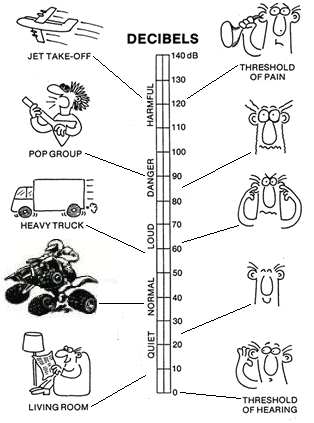| All-terrain vehicles (ATVs), also known as three- and four-wheelers, were first built in Japan for use in isolated, mountainous areas. It wasn't long, however, before ATVs became popular recreational vehicles here in America. And, although ATVs continue to provide their riders with thrills, many don't understand how to balance the risk and pleasure of riding the trails.
According to the Consumer Product Safety Commission, as many as 90,000 people were treated in hospital emergency rooms for ATV-related injuries during 1995. Nearly 10,000 of those were hospitalized, and more than 120 died of their injuries. Nearly half of the injuries and fatalities occurred to riders under 16, while 20 percent of the fatalities were children under 12. ATVs are not toys, and children under 12 should not operate or ride on one. Such young riders often lack the size and strength to safely control an ATV.
While riding an ATV can be dangerous, it doesn't have to be--so long as you balance the risks and pleasures involved. Fortunately, it's mostly a matter of common sense. For instance, consider the trails you'll be on, and ask yourself if you'll be encountering any terrain or environmental hazards. Give special attention to terrain features such as roads, slopes, canals, ditches, blind intersections, trees, shrubs, other vehicles--anything that might cause accidents. It's difficult to avoid potential accident situations if you're not aware of the hazards. To safely enjoy riding the trails, ask yourself these questions.
Am I ready to ride?
Don't be an unprepared operator, and don't permit others to operate an ATV if they are not prepared. A hands-on training course, given by a competent instructor, is necessary for all ATV operators. Riders should also be physically strong and emotionally mature. Inexperienced operators in their first month of using an ATV have 13 times the average risk of injury.
- Be familiar with the ATV owner's manual, particularly with the operation and safety aspects.
- Be alert, awake, and clear-headed.
- Wear all appropriate personal protective equipment.
Is my ATV ready?
It requires more than having enough fuel and starting the engine. The ATV should be maintained according to the owner's manual.
Give special attention to the tires, brakes, and throttle. The tires must be uniformly inflated (2 to 6 psi); a one-pound difference in air pressure can cause control problems. To accurately measure pressure, you will need a low-pressure gauge--regular tire gauges will not be accurate enough.
The brakes must be adjusted to ensure a safe, straight stop. Make sure the throttle operates smoothly in all steering positions. Regularly check all bolts and nuts, particularly the axle and wheel lug nuts. When you change a wheel, tighten the lug nuts every two hours until they set.
Do I know the basics?
Do not ride double; the unique handling characteristics of the ATV require operators to shift their weight and position on the seat to steer and control the vehicle. Riders hamper this operation.
Always wear helmets (should bear the American National Standards Institute label ANSI Z90.1 or equivalent), heavy gloves, and boots. Without the protection of a helmet, the risk of severe injury or death is twice as high.
Because ATVs are small and low to the ground, they are not as visible as larger vehicles. Use lights, reflectors, and highly visible flags so the ATV is easier to see.
Never ride an ATV after taking alcohol or medications. In nearly 10 percent of all injuries and in 30 percent of all fatal ATV mishaps, alcohol use was a contributing factor.
Am I pushing my limits?
Don't try things beyond your ability. If you come upon a trail-riding area or obstacle where you're not sure of how to handle the ATV or what you would do in a worst-case scenario, don't do it. Take a minute and think: Is my ability up to it? Is the ATV up to what I'm about to try? Am I by myself? How far away is help? Traveling with a buddy (on a second ATV) is the safe way.
If you are alone remember that any accident far from help can result in a minor injury becoming serious, and a serious injury becoming fatal. Proceed only after you're satisfied you can deal with the consequences of your actions.
Do I know how to handle obstacles?
Often you'll have more success climbing over obstacles by approaching them straight-on. This holds true for downed trees, as well as hill climbing.
With 4X4 ATVs, approach the obstacle very slowly. Once the wheels are touching it, give just enough throttle to slowly crawl over the obstacle. If you use too much throttle, you may end up doing a wheelie. When your front wheels pass over the obstacle, keep the momentum going so your rear tires also will make it.
Don't traverse a hill sideways. Always climb straight up or straight down. Your ATV's weight and the spinning wheels can cause you to slide farther sideways than you intended. Depending on the steepness of the slope, sliding sideways can cause ATVs to roll over.
Sometimes you'll need to turn around--never attempt to turn around on a steep, narrow trail. If the terrain is unstable and your ATV gets sideways, you could roll over. If you fail to climb the hill, immediately grab your brakes hard. If possible, put the ATV in reverse, then let the engine compression and front brakes slow you while you back straight down the hill.
Know what's ahead. Know what to expect from the trail you're riding on and how difficult it is prior to getting there. If you're not sure of the trail conditions, be prepared for the worst.
Although it seems ATVs, by their very nature, can be dangerous, they're also exciting and fun. If the ATV is maintained, if the operator is trained, clothed and equipped and has weighed all the risks, then riding the trails can be a pleasure.There are off-highway courses for both ATVs and off-road motorcycles sponsored by the Specialty Vehicle Institute of America. SVIA contacts all purchasers of new ATVs and offers a course at no cost to the individual. Most dealers are aware of this arrangement and participate with SVIA in getting new riders into courses. The DoD-specified course is the SVIA course. The dealer or SVIA can provide information.
Though not as widespread, the Off Highway Motorcycle (OHM) course is available from SVIA. OHM courses are available in Southern California. Again, the dealer or SVIA can provide information.
SVIA and the Motorcycle Safety Foundation also have excellent materials regarding the use of off-road motorcycles and ATVs and information about their courses and safety materials.
Additional ATV Training Information
Specialty Vehicle Institute of America (SVIA)
All Terrain Vehicle Safety Institute (ASI)
2 Jenner St., Suite 150
Irvine, Calif. 92718
(949) 727-3727 (off-highway motorcycle training)
ASI is a division of SVIA. ASI is a non-profit association founded by the major U.S. distributors of ATVs. Supporting members are American Honda Co., Inc; Yamaha Motor Corporation, U.S.A.; American Suzuki Motor Corporation; and Kawasaki Motors Corporation, U.S.A.
ATV Enrollment Express, (800) 887-2887
ATV Enrollment Express provides free training for personnel who buy new ATVs manufactured by American Honda Co., Inc.; Yamaha Motor Corporation, U.S.A.; American Suzuki Motor Corporation; and Kawasaki Motors Corporation, U.S.A. They also will provide the same training for a nominal charge (usually $35.00) for personnel who own a used ATV. The course includes: riding an ATV at a track to learn how to handle it, ATV safety features, and demonstration of proficiency on the ATV.
A training pamphlet also is available; it's called "Tips and Practice Guide for the ATV Rider." You can get a copy by calling Ms. Karen Walsh at (949) 727-3727, Ext. 3015.
Polaris Safety Line, (800) 342-3764
Another manufacturer of ATVs is an American brand called Polaris. You can find out about their free training course when you buy a new Polaris ATV.
They will also provide the same training for a nominal charge (cost varies with each dealer) for personnel who buy a used ATV. The course includes a safety video, riding an ATV on a track to learn how to handle it, safety features of ATVs, and a demonstration of proficiency on the ATV. | 













